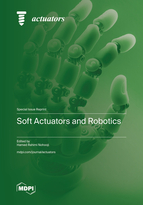Soft Actuators and Robotics
A special issue of Actuators (ISSN 2076-0825). This special issue belongs to the section "Actuators for Robotics".
Deadline for manuscript submissions: closed (1 November 2023) | Viewed by 24489
Special Issue Editor
Interests: soft robotics; reconfigurable robotics; robot control; robotic manipulation and grasping
Special Issues, Collections and Topics in MDPI journals
Special Issue Information
Dear Colleagues,
Relying on their soft bodies, soft actuators and robots are a naturally safe solution to bridge the gap between machines and humans. They can adapt to complex and dynamic environments thanks to their flexibility and compliance. This makes them remarkably advantageous in several applications in developing soft grippers, wearables and haptic devices, artificial muscles, and medical devices.
This Special Issue aims to cover different aspects of the recent advances in soft actuators and robotics, including the development of architectures and modules for fabrication, modeling, sensing, analysis, and control of soft actuators and robotics. Submissions examining how the performance of soft actuators and robotics can be improved and those discussing adaptability, multimodal locomotion, self-healing, and multi-responsiveness of such robots are particularly welcome.
Topics of interest for this collection include but are not limited to:
- Compliant mechanisms in soft actuators and robotics;
- Artificial muscles with embedded proprioceptive sensors and electronics;
- Materials and structural designs of soft actuators;
- Programmable soft materials in soft actuators and robotics;
- Modeling and simulation of sensorized actuators;
- Model-based control of soft actuators and robotics;
- Data-driven models in soft actuators and robotics;
- Learning control of soft actuators and robotics;
- Topology-optimized design in soft actuators and robots;
- Untethered synthetic soft actuator;
- Soft actuators in soft grippers;
- Soft actuators to develop complex soft robots;
- Real-world applications of soft actuators.
Dr. Hamed Rahimi Nohooji
Guest Editor
Manuscript Submission Information
Manuscripts should be submitted online at www.mdpi.com by registering and logging in to this website. Once you are registered, click here to go to the submission form. Manuscripts can be submitted until the deadline. All submissions that pass pre-check are peer-reviewed. Accepted papers will be published continuously in the journal (as soon as accepted) and will be listed together on the special issue website. Research articles, review articles as well as short communications are invited. For planned papers, a title and short abstract (about 100 words) can be sent to the Editorial Office for announcement on this website.
Submitted manuscripts should not have been published previously, nor be under consideration for publication elsewhere (except conference proceedings papers). All manuscripts are thoroughly refereed through a single-blind peer-review process. A guide for authors and other relevant information for submission of manuscripts is available on the Instructions for Authors page. Actuators is an international peer-reviewed open access monthly journal published by MDPI.
Please visit the Instructions for Authors page before submitting a manuscript. The Article Processing Charge (APC) for publication in this open access journal is 2400 CHF (Swiss Francs). Submitted papers should be well formatted and use good English. Authors may use MDPI's English editing service prior to publication or during author revisions.
Keywords
- soft robotics
- soft actuators
- manufacturing methods in soft robotics
- topology optimization in soft robotics
- modeling and control of soft robotics
- AI in soft robotics
- soft grippers






